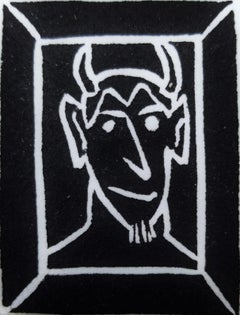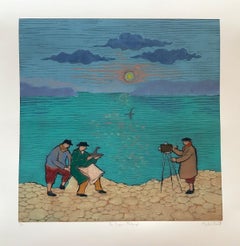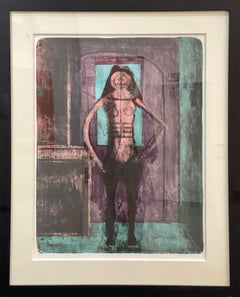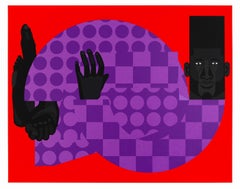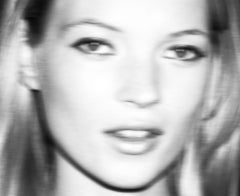Portrait Prints
to
1,895
3,661
1,496
1,684
1,081
755
Overall Width
to
Overall Height
to
2,247
1,948
817
387
326
212
168
165
131
120
96
15
12
10
269
172
108
96
92
348
1,514
4,386
2,455
64
135
185
163
239
244
483
861
645
306
285
6,574
1,563
509
6,463
3,550
3,055
2,597
1,909
1,551
1,216
1,101
938
788
760
416
378
362
245
212
200
189
176
169
3,070
1,851
1,598
900
771
1,275
3,352
4,807
2,771
Portrait Prints For Sale
Devil /// Contemporary Pop Art Minimalism Linocut Black and White Art Religious
By Dan May
Located in Saint Augustine, FL
Artist: Dan May (American, 1955-)
Title: "Devil"
*Signed and numbered by May in pencil lower left
Year: 1999
Medium: Original Linocut on white Hosho handmade paper
Limited edition: 2...
Category
1990s Contemporary Portrait Prints
Materials
Linocut
The Surgeon’s Photograph by Mychael Barratt, limited edition woodcut print
Located in Deddington, GB
The Surgeon’s Photograph by Mychael Barratt [2022]
limited_edition and hand signed by the artist
Woodcut Print on Paper
Edition number of 50
Image size: H:50 cm x W:49 cm
Complete S...
Category
21st Century and Contemporary Contemporary Portrait Prints
Materials
Paper, Woodcut
Femme au Collant Noir, 1969, (4/150)
Located in San Francisco, CA
Rufino Tamayo
Femme au Collant Noir, 1969
Color lithograph
Unframed dimensions: 27.50 x 21 in
Framed dimensions: 37.625 x 30.75
Edition 4/150
This limited edition color lithograph i...
Category
1960s Abstract Portrait Prints
Materials
Color, Lithograph
Beach Party-Limited Edition Giclée on Unstretched Canvas
Located in Chesterfield, MI
HC 1/50. Signed by the artist on the back. Image measures 12 x 36 inches. Canvas is Unstretched. Excellent Condition. Can be stretched if customer wishes, or...
Category
Late 20th Century Portrait Prints
Materials
Canvas, Giclée
$120 Sale Price
20% Off
The Man in the Violet Suit (Red No.1)
Located in London, GB
Screenprint with 7 colour and varnish on Somerset Velvet White 300 gsm paper
Signed by the artist and numbered, 76 x 60 cm
Edition of 75
Jon Key’s paintings o...
Category
2010s Contemporary Portrait Prints
Materials
Screen
Ohh Baby ! - Oversize Signed limited edition - Pop Art - Kate Moss
By BATIK
Located in London, GB
Ohh Baby ! - Oversize Signed limited edition - Pop Art - Kate Moss
by the London based contemporary pop art
image creator and artist, BATIK.
Measures 30 x 20" inches / 76 x 51 cm...
Category
2010s Pop Art Portrait Prints
Materials
Color, Archival Pigment
The Hero, 2001 (Hand Signed by Marina Abramovic with Royal Academy label) Framed
Located in New York, NY
Marina Abramovic
Offset lithograph poster
The Hero, 2001 2023
Boldly signed in black marker on the image of the flag
Bears Royal Academy authentication label on the back of the fram...
Category
Early 2000s Contemporary Portrait Prints
Materials
Lithograph, Offset
Philippe Halsman "Marilyn Monroe" Silver Print
Located in Astoria, NY
Philippe Halsman (American, 1906-1979), "Marilyn Monroe", Gelatin Silver Print, 1952, printed later, apparently unsigned, inscribed "1952 Philippe Halsman" to verso, unframed. Image:...
Category
Mid-20th Century Portrait Prints
Materials
Silver Gelatin
David Salle, Woman with Raised Arm
By David Salle
Located in New York, NY
WOMAN WITH RAISED ARM
Year: 2020
Medium: Archival pigment ink on Innova Etching Cotton Rag 315 gsm fine art paper
Size: 58 x 42 in (147 x 107 cm)
Edition: 50
Price: $5,000
David Sa...
Category
2010s Contemporary Portrait Prints
Materials
Archival Pigment
Reflection
By Leonor Fini
Located in Columbia, MO
Leonor Fini was born in Argentina in 1907 but travelled and lived in Europe with her mother from a young age. By 1931, she was in Paris, in the full swing of the Surrealist movement....
Category
20th Century Surrealist Portrait Prints
Materials
Archival Paper, Etching
Merieanna
Located in Fairlawn, OH
Merieanna
Etching and aquatint, c. 1900
Signed by the artist in pencil lower right
Titled in pencil lower right corner of sheet
Annotated "4" lower left below image
Publisher's dryst...
Category
Early 1900s Impressionist Portrait Prints
Materials
Aquatint
JOE MCDONALD
Located in Portland, ME
Hockney, David. JOE MCDONALD. Scottish Arts Council 175. Gemini DH76-767.
Lithograph in two blacks, 1976. Done in crayon on both a stone and an aluminum ...
Category
1970s Portrait Prints
Materials
ABS, Lithograph
Art Deco Jazz Age Paris Interracial Couple Lovers Marcel Vertes Color Lithograph
Located in Surfside, FL
Marcel Vertes (French /Hungarian 1895-1961) Tango, from the suite Dancing, Jazz age in Paris. lithograph in colors on paper, published by Gustave Pellet-Paris, hand signed in pencil, lower right.
Mounted in chrome frame with matting. Measures 23.75"H x 30.5"W framed; 15"H x 21.5"W image.
Gustave Pellet (1859–1919) was a French publisher of art. He is best known for publishing prints of erotic artworks by Henri de Toulouse-Lautrec and Louis Legrand.
MARCEL VERTES FRENCH HUNGARIAN 1895 (Ujpest, Hungary) -1961(Paris, France) art deco artist.Vertes was born in Hungary and died in Paris, but spent a lot of time in New York as well. He was noted as a painter, illustrator, designer and scenic mural painter. His whimsical images graced the pages of Vogue and Harper's Bazaar. Continuing in the footsteps of Boutet, Forain, Erte, Toulouse-Lautrec and others. Concentrating upon scenes of Paris street life...
Category
1940s Art Deco Portrait Prints
Materials
Lithograph
Rare poster hand signed by Marina Abramovic, framed, Royal Academy label, 2011
Located in New York, NY
Marina Abramovic
The Spirit in Any Condition Does Not Burn (Hand signed by Marina Abramovic, with provenance label from the Royal Academy) 2011, 2023
Offset lithograph poster (hand ...
Category
2010s Performance Portrait Prints
Materials
Lithograph, Offset
Poster-Romm Art Editions ltd, B&R International Art
By Isaac Maimon
Located in Chesterfield, MI
ISAAC MAIMON (Israeli, b.1951). Poster-Romm Art Editions ltd, B&R International Art. Plate signed. Measures 24 x 36 in. Unframed. Good Condition.
Category
1990s Portrait Prints
Materials
Lithograph
$140 Sale Price
20% Off
The Search
Located in London, GB
Alberto Giacometti
The Search , ca. 1968
Restrike Etching
unsigned
comes with COA from publishers
25.4 × 20.3 cm
51 x 40.5 cm (framed)
Category
1960s Modern Portrait Prints
Materials
Lithograph
The Shadow (from Myths)
By Andy Warhol
Located in Palm Desert, CA
A color screen print with diamond dust by Andy Warhol. "The Shadow" is a self-portrait print executed in a dark, bold palette of browns and blacks by American Pop Artist Any Warhol. ...
Category
Late 20th Century Pop Art Portrait Prints
Materials
Screen
Portrait of John F. Kennedy
Located in Paonia, CO
Portrait of Kennedy by Cemeli is an original lithograph, limited edition number 52 out of 150 and pencil signed by the artist. Kennedy is portrayed as a sculptured multi-colored hea...
Category
1960s Cubist Portrait Prints
Materials
Lithograph
$750 Sale Price
21% Off
Teddo
By Paul Cadmus
Located in New York, NY
This refined work on paper, entitled "Teddo" was produced by the celebrated American artist Paul Cadmus (1901-1999) in 1985. It features a nude male figure with tightly cropped hair ...
Category
1980s American Realist Portrait Prints
Materials
Lithograph
$3,475
Yoshitomo Nara, Girl in the Moon - Limited Edition Plate, Japanese Art
Located in Hamburg, DE
Yoshitomo Nara (Japanese, born 1959)
Girl in the Moon, 2022
Medium: Porcelain plate (fine bone china)
Dimensions: 10 1/2 in diameter 26.7 cm diameter
Edition of 250: Printed signatu...
Category
21st Century and Contemporary Pop Art Portrait Prints
Materials
Porcelain
Dancer 1
By Alex Katz
Located in New York, NY
Alex Katz
Dancer 1
2019
Silkscreen in colors on Saunders Waterford HP High White 425 gsm paper
60 x 36 inches (153 x 92 cm)
Edition of 60
Category
2010s Pop Art Portrait Prints
Materials
Screen
$18,000
"John Belushi Mugshot" Print 39 x 36 inch Ed. of 75 by Gerard Marti
By Gerard Marti
Located in Culver City, CA
"John Belushi Mugshot" Print 39 x 36 inch Ed. of 75 by Gerard Marti
Digital print on paper.
Ships rolled in a tube.
Signed and numbered by the artist.
John Belushi poses for the ...
Category
21st Century and Contemporary Pop Art Portrait Prints
Materials
Canvas, Digital
Shepard Fairey "Rose Soldier Letterpress Edition" Screenprint
Located in Draper, UT
Edition Details:
Year: 2017
Class: Letterpress Art Print
Released: 10/10/17
Run: 219/450
Technique: Letterpress
Paper: Cream cotton paper
Size: 10 X 13
Markings: Signed & Numbered
Category
2010s Street Art Portrait Prints
Materials
Screen
Untitled Offset Lithograph (2020) by Izumi Kato (framed)
By Izumi Kato
Located in Hong Kong, HK
Untitled . Offset Lithograph by Izumi Kato
Printed in 2020 for the Exhibition at Perrotin Gallery Paris
Sheet size: 58.5 × 39 cm (Framed 63 x 43 cm)
Category
2010s Tribal Portrait Prints
Materials
Lithograph, Offset
THE CLASP
By Erté
Located in Aventura, FL
Hand signed and numbered by the artist. From the Roman Numeral edition of 150. Framed size approx 50 x 34 inches.
Artwork is in excellent condition. Certificate of Authenticity inc...
Category
1980s Art Deco Portrait Prints
Materials
Paper, Screen
$3,150 Sale Price
30% Off
Salvador Dali - La Fontaine Portrait - Handsigned Engraving
Located in Collonge Bellerive, Geneve, CH
Salvador Dali - La Fontaine Portrait - Handsigned Engraving
1974
Hand signed by Dali
Edition: /250
The dimensions of the image are 22.8 x 15.7 inches on 31 x 23.2 inch paper
Referenc...
Category
1970s Surrealist Portrait Prints
Materials
Drypoint, Aquatint
Annette, Surrealist Lithograph by Peter Paone
Located in Long Island City, NY
Peter Paone, American (1936 - ) - Annette, Year: circa 1963, Medium: Lithograph on Rives, signed, titled and numbered in pencil, Edition: 50, Image Size:...
Category
1960s Surrealist Portrait Prints
Materials
Lithograph
Tango, Surrealist Etching on Fabriano Italia Paper by Leonor Fini
By Leonor Fini
Located in Long Island City, NY
Tango
Color Etching on Fabriano Italia, signed and numbered in pencil
Edition of 36/280
Image Size: 17 x 14.5 inches
Size: 26 x 19 in. (66.04 x 48.26 cm)
Category
Late 20th Century Portrait Prints
Materials
Etching
VENDEDORA Signed Lithograph, Portrait Seated Young Girl, Mexican Fruit Seller
Located in Union City, NJ
VENDEDORA, a limited edition lithograph by the renowned American-born Mexican sculptor and printmaker Elizabeth Catlett(b.1915–2012) depicts a sensitive black and white portrait of a...
Category
Early 2000s Realist Portrait Prints
Materials
Lithograph
lithograph for Florilege des amours de Ronsard
Located in Henderson, NV
Medium: lithograph (after Matisse). Printed in sanguine ink on cream laid paper from the Papeteries Casteljoux and published in Geneva by Edito-Service in 1970. This reproduces one o...
Category
1970s Portrait Prints
Materials
Lithograph
Painting in Gold Frame
Located in Aventura, FL
From the Paintings series. Woodcut, Lithograph, screen print and collage on Arches 88 paper. Hand signed, dated and numbered by Roy Lichtenst...
Category
1980s Pop Art Portrait Prints
Materials
Lithograph, Screen, Woodcut, Paper
Original 'Moteur Auxiliaire Cyclex' vintage French motorized bicycle poster
Located in Spokane, WA
Original Moteur Auxiliaire Cyclex vintage mid-century modern vintage bicycle poster. Eye-catching artwork depicting a cyclist in motion, we...
Category
1940s American Modern Portrait Prints
Materials
Lithograph
$520 Sale Price
20% Off
Bob Marley 40th 1 Soul Rebel Signed & Numbered Letterpress OBEY Shepard Fairey
Located in Draper, UT
This letterpress set in collaboration with photographer Dennis Morris commemorates the 40th anniversary of Bob Marley's passing. The series represents the amazing breadth of Marley's...
Category
2010s Contemporary Portrait Prints
Materials
Screen
DaVinci Tee Threesome, Signed Lithograph, Group Portrait, Pizza, Orange, Rust
Located in Union City, NJ
DaVinci Tee Threesome is an original hand drawn lithograph by the NY figurative expressionist painter, Lester Johnson(1919-2010). DaVinci Tee Threesome was printed using hand lithogr...
Category
1980s Contemporary Portrait Prints
Materials
Lithograph
Orientale à la croix trifoliée
Located in London, GB
Lithograph on Arches Velin paper, Edition of 50
Paper size: 65 x 50.5 cms (25 1/2 x 19 7/8 ins)
Image size: 54.3 x 45 cms (21 3/8 x 17 3/4 ins)
Category
1920s Impressionist Portrait Prints
Materials
Lithograph
$40,000 Sale Price
27% Off
Portrait of a Woman in Red
Located in London, GB
Giclee print with a two-layer silkscreen varnish
Printed on Somerset Velvet 300gsm deckle edged paper
hand-signed limited edition of 25 + 5 AP
86 x 74 cm - sheet size
Jake Wood...
Category
2010s Contemporary Portrait Prints
Materials
Giclée
Julian Opie, Male Walker (Grey) - Contemporary Sculpture, British Pop Art
By Julian Opie
Located in Hamburg, DE
Julian Opie (British, b. 1958)
Male Walker - Grey, 2020
Medium: Laser cut acrylic, two-part statuette
Figure measures: 25 x 11.5 x 0.5 cm
Base measures: 7.5 x 5 x 1 cm
Edition size:...
Category
21st Century and Contemporary Pop Art Portrait Prints
Materials
Acrylic Polymer
SULTRY Signed Original Lithograph, Modern Female Portrait, Slicked Back Hair
By Robin Morris
Located in Union City, NJ
SULTRY by the woman artist Robin Morris, is an original limited edition lithograph printed using hand lithography techniques on archival Coventry Rag paper, 100% acid free. SULTRY is...
Category
1980s Contemporary Portrait Prints
Materials
Lithograph
Emilio Grau Sala - Original Handsigned Lithograph - Ecole de Paris
Located in Collonge Bellerive, Geneve, CH
Emilio Grau Sala
Original Handsigned Lithograph
Dimensions: 76 x 54 cm
Edition: HC XXI/XXX
HandSigned and Numbered
Ecole de Paris au seuil de la mutation des Arts
Sentiers Editions ...
Category
1960s Post-Impressionist Portrait Prints
Materials
Lithograph
Antique European School Engraving Portrait of a Woman with Water Jug
Located in San Francisco, CA
Antique European School Engraving Portrait of a Woman with Water Jug
A beautiful young woman taking a break from collecting water
Original antiq...
Category
Early 20th Century Impressionist Portrait Prints
Materials
Engraving
"Love Letter, After Kunimasa" original lithograph signed romantic pop art lovely
Located in Milwaukee, WI
"Love Letter, After Kunimasa" is a hand-painted lithograph by Michael Knigin. It is signed in the lower right and is edition 16/200. This print is inspired by the Ukiyo-e prints of U...
Category
1970s Contemporary Portrait Prints
Materials
Lithograph, Ink
L'album des demeures d'Hypnos, Lithograph by Man Ray
By Man Ray
Located in Long Island City, NY
An original hand-signed lithograph and numbered lithograph by influential artist and photographer, Man Ray. The print measures 19.25 x 12.5 inches and is numbered 46/99. Nicely fram...
Category
1970s Dada Portrait Prints
Materials
Lithograph
GATHERING Signed Stone Lithograph, NYC Group Portrait Drawing, Brown
Located in Union City, NJ
GATHERING is an original hand drawn stone lithograph by Raphael Soyer, the renowned Russian-born American realist painter, draftsman, and printmaker. Hand proofed and printed in 1977...
Category
1970s Realist Portrait Prints
Materials
Lithograph
Leonor Fini, rare lithograph on Arches paper, circa 1980
By Leonor Fini
Located in Saint Ouen, FR
Rare print handsigned by surrealist artist Leonor Fini, inscreasingly esteemed with the movement of rediscovering art by women. This rare original lithograph is an artist proof in ve...
Category
Mid-20th Century Surrealist Portrait Prints
Materials
Paper
La jineta (The Jockey)
Located in San Francisco, CA
Arturo Rivera
La jineta (The Jockey)
Serigraph
33.46 x 29.52 in
Edition 96 of 100
Serigraph by Mexican artist Arturo Rivera. Edition 96 of 100. Certificate of authenticity included....
Category
21st Century and Contemporary Contemporary Portrait Prints
Materials
Paper, Screen
after Henri Matisse, "Sitting Blue Nude"
Located in Collonge Bellerive, Geneve, CH
Lithograph after Henri Matisse - Sitting Blue Nude
Artist : after Henri MATISSE
Edition of 200
76 x 56 cm
With stamp of the Succession Matisse
References : Artvalue - Succession Ma...
Category
1950s Modern Portrait Prints
Materials
Lithograph
Chez Panisse 21st Birthday Celebration: Limited Ed. Goines Graphic Art Poster
Located in Alamo, CA
This original limited edition graphic art lithographic poster entitled "Chez Panisse Twenty-First Birthday" was created by David Lance Goines in 1992 in h...
Category
Late 20th Century Portrait Prints
Materials
Lithograph
Woman, Modern Lithograph by George Lockwood
Located in Long Island City, NY
George Lockwood, American (1929 - 1969) - Woman, Year: circa 1963, Medium: Lithograph, signed, and numbered in pencil, Edition: AP, Image Size: 15.75 x 11.5 inches, Size: 20 x 13 i...
Category
1960s Modern Portrait Prints
Materials
Lithograph
Femme en Buste
Located in New York, NY
Color lithograph. The deluxe edition of 200 signed by Picasso in red crayon and numbered 83/200 in pencil, lower left. Printed by Mourlot, Paris, with the watermark.
This is the del...
Category
1950s Modern Portrait Prints
Materials
Lithograph, Color
$4,500
Pierre-Auguste Renoir, L'Enfant au Biscuit
Located in Chatsworth, CA
This piece is an original lithograph by Pierre-Auguste Renoir, done in 1899. This piece was created for the unpublished "L'album d'estampes de la Galerie Vollard". It is a rare tri...
Category
1890s Impressionist Portrait Prints
Materials
Lithograph
LADIES & GENTLEMEN FS II.130
By Andy Warhol
Located in Aventura, FL
From the Ladies and Gentlemen Portfolio. Screenprint in colors on arches paper. Hand signed and numbered by the artist on verso. Artwork sheet size 43.33 x 28.5 in. Framed. From...
Category
1970s Pop Art Portrait Prints
Materials
Paper, Screen
Becquet
Located in Storrs, CT
J. Becquet, Sculptor (The Fiddler). 1859. Drypoint. Kennedy 52 state iv; Glasgow 62. state i. 10 1/8 x 7 1/2 (sheet 15 5/16 x 9 3/4). Series: "Sixteen Etchings or Scenes on the Thame...
Category
Mid-19th Century American Impressionist Portrait Prints
Materials
Drypoint, Etching
A Womans Strength
Located in Deddington, GB
A Womans Strength by Amy Gardner [2021]
limited_edition
Mono Print/Screen Print
Edition number 23
Image size: H:42 cm x W:59.4 cm
Complete Size of Unframed Work: H:42 cm x W:59.4 cm...
Category
21st Century and Contemporary Pop Art Portrait Prints
Materials
Paper, Monoprint, Screen
Maternité, Cubist Lithograph after Pablo Picasso
Located in Long Island City, NY
Pablo Picasso, After, Spanish (1881 - 1973) - Maternite, Portfolio: Marina Picasso Estate Lithograph Collection, Year: of Original: 1921 Year Printed: 1979-1982, Medium: Lithogra...
Category
1980s Cubist Portrait Prints
Materials
Lithograph
The Swiss Lieutenant - Etching by Giuseppe Capparoni - 1828
Located in Roma, IT
The Swiss Lieutenant is an Artwork realized in 1828 by the Engraver, Giuseppe Capparoni (Rome 1800- 1879).
Etching hand colored on ivory paper. Signed on plate and dated on the rig...
Category
1820s Modern Portrait Prints
Materials
Etching
'40 HP in a dinghy', Vanity Fair naval portrait chromolithograph, 1906
Located in Melbourne, Victoria
'The Cavalry Division'
Vanity Fair portrait of Admiral Sir Compton Edward Domvile GCB GCVO (1842-1924) who was a distinguished Royal Navy officer in the Edwardian era.
390mm by 26...
Category
Early 20th Century Victorian Portrait Prints
Materials
Lithograph
CLOSE UP Hand Drawn Lithograph Closeup Crowd Portrait Blondie T-Shirt, Cigarette
Located in Union City, NJ
CLOSE UP is an original hand drawn lithograph by the NY figurative expressionist painter, Lester Johnson. Printed using hand lithography techniques on archival ARCHES paper 100% acid...
Category
1980s Contemporary Portrait Prints
Materials
Lithograph
Samuel Loates, jockey, Vanity Fair horse racing portrait chromolithograph, 1896
Located in Melbourne, Victoria
'Sam Loates'
Vanity Fair portrait of Samuel "Sam" Loates (1865 - 1932) was a British Thoroughbred horse racing jockey who was the Champion Jockey of 1899.
395mm by 265mm (sheet)
Category
Late 19th Century Victorian Portrait Prints
Materials
Lithograph
Henry Searle, rower, Vanity Fair rowing portrait chromolithograph, 1889
Located in Melbourne, Victoria
'H Searle, Professional Champion Sculler of the World'.
Vanity Fair rowing portrait of Henry Searle (1866-1889), an Australian sculler who raced in...
Category
Late 19th Century Victorian Portrait Prints
Materials
Lithograph
Amleto Dalla Costa artist, "Woman in a Green Hat"
Located in Chesterfield, MI
Abstract portrait
Limited edition lithograph
Signed, numbered 289/325
Amleto Dalla Costa was an Italian painter and sculptor known for his abstract and ...
Category
20th Century Abstract Expressionist Portrait Prints
Materials
Lithograph
$240 Sale Price
20% Off
